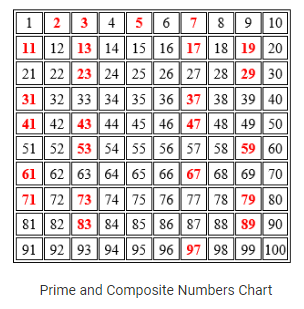Prime numbers and composite numbers are two types of natural numbers, the only difference between them is based on the number of factors they have. This page will give you all the details about prime numbers and composite numbers along with examples and charts.
Do Check:
Prime Numbers – Definition
If any natural number is having only two factors among which one factor will be 1 and the other factory will be the number itself, then those natural numbers are called prime numbers.
Types of Prime Numbers
There are two types of prime numbers
- Twin Primes
- Co-Primes
Twin Primes
Take any two prime numbers and subtracting them, if the result is 2 then those two prime numbers are considered as Twin primes. In other words, if two consecutive prime numbers have only one number between them, then those two consecutive prime numbers are called twin prime numbers.
Let me explain to you clearly with one example.
How to find Twin Prime numbers?
As we already know 2, 3, 5, 7, 11, 13, 17 are few prime numbers.
Now let us take 2,3 and check whether these two prime numbers are twin primes.
3-2=1 the difference is not equal to 2 so 2,3 are not twin primes
Now let us take another pair of prime numbers 3,5
5-3=2 the difference of these two prime numbers is equal to 2. This means 3,5 are Twin primes.
Example of Twin Primes
In the same way, 5,7, and 11,13 are few examples of twin primes.
Co-Prime Numbers
If two prime numbers have only 1 as their common factor, then those two prime numbers are called Co-Primes. Co-primes are also called Mutual prime numbers and Relative Prime numbers.
How to find Co-Prime Numbers?
Now let us take 14,15 two prime numbers and check whether they are Co-primes.
The factors of prime number 14 are 1, 2 and 7
Whereas the factors of prime number 15 are 1, 3, and 5.
For both the numbers, we can see that the common factor is 1. So, 14 and 15 are coprime numbers. But if we consider another prime number 21, whose factors are 1, 3, and 7. Then, 21 is neither a Co-prime number for 14 nor 15.
Examples of Co-Prime numbers.
In the same way, 3 & 37, 54 & 67, 34 &79 are few examples of Co-Prime Numbers.
How to find if a Number is Prime or Not?
We have to follow few simple steps to check whether a given number is a prime number.
- First of all, find the factors for the given number
- Now, count the number of factors obtained
- If the count is more than 2, then definitely the given number is not a prime number.
- If in case the count is equal to 2 then the given number is a prime number.
Now let us follow the above steps to find a prime number. Assume 3 as a prime number, we already know 3 can be divided by only two number’s which are 1 and 3 itself.
Which are 3/1 = 3 and 3/3 =1
This proves our assumption is correct, So 3 is a prime number.
Examples of Prime numbers.
In the same way 2, 5, 7, 11, 13, 17… are also few prime numbers.
How to Check if a Number is Prime or Not for Larger Numbers?
If the given number is a smaller number then we can simply follow the above steps to find the factors, But if the given number is a larger number it will be very difficult to find all its factors.
So in that case, we can follow the below-mentioned steps to find whether the given number is a prime number or not.
- When a larger number is given always check the number which is in the unit’s place. If the given numbers end with 0,2,4,5,6 and 8 then the given number will not be a prime number.
- If the given number is not ending with any of the above-mentioned numbers then, add all the digits of the given number and divide the sum by 3, if the sum of the digits is divisible by 3 then the given number will not be a prime number.
- If the given number satisfies the above-mentioned two steps, then find the square root for the given number and divide the number by all the prime numbers (that you know) below the obtained square root value, While dividing if any of the prime numbers are divisible by less than its square root value. Then the given number will not be a prime number.
Whenever you’re not able to find the factors for the given number follow the above-mentioned three steps.
Composite Numbers
Unlike prime numbers, Composite numbers have more than 2 factors. this means apart from getting divided by 1 and the number itself, it can also be divided by at least one another number.
How to find if it’s a Composite Number or Not?
We have to follow few simple steps to check whether a given number is a composite number.
- First of all, we need to find the factors for the given number
- Now, count the number of factors that are obtained.
- If the count is is equal to 2 then the given number is a prime number so it can’t be a composite number.
- If in case the count is more than 2, then we can say that the given number is a composite number.
Now let us follow the above steps to find a composite number. As already know 2,3 are prime numbers, let us check whether 4 is a composite number.
As we know 4 can be divided by 1, 2, and 4. This means number 4 is having 3 factors, In other words, number 4 has more than 2 factors. So 4 is a composite number.
Examples of Composite Numbers
In the same way 4,6,8,9,10,12,14.. are few composite numbers.
How to Identify if a Number is Composite or Not for Larger Numbers?
If the given number is a smaller number then we can simply follow the above steps to find the number of factors, But if the given number is a larger number it will be very difficult to find all its factors.
So in that case, we can follow the below-mentioned simple steps to find whether the given number is a composite number or not.
- We can find out whether the given number is a composite number or not by doing a divisibility test.
- If the given number is if the number can be divided by these numbers 2, 3, 5, 7, 11, and 13.
- If the given number ends with either a 0 or 5, then try to divide the given number by 5.
- If the given number can’t be divided by any of the above-mentioned six numbers, then the number is most likely a prime number which means it will not be a composite number.
Prime Number and Composite Number Chart
The below chart shows all the prime and composite numbers from 1 to 100.
- Numbers in Red color are Prime numbers.
- Numbers in Blue color are Composite numbers.

FAQs on Prime Numbers and Composite Numbers
1. Are all the prime numbers, natural numbers?
Yes, all the prime numbers are natural numbers.
2. Can 1 be considered as a Composite Number?
No, 1 is not a composite number.
3. What is the smallest composite number?
Composite numbers start from 4, So 4 is the smallest composite number.
4. What is the smallest prime number?
Prime numbers start from 2, So 2 is the smallest prime number.
